General comments
I am willing to make a bet with you: the most exposed vintage watch on Instagram is the Rolex Daytona.
The Daytona, whose name derives from the legendary racetrack in Florida- is the cool watch to have. The Daytona enjoys tremendous popularity today, despite it being a flop when introduced back in 1964 (believe it or not the most difficult to sell at the time was the exotic Paul Newman dial – these watches would sit for years unsold in stores). The Daytona – let’s give the watch credit- is a beautiful and good looking watch. It has history, provenance (Paul Newman), legitimacy in terms of it becoming an asset class (Daytona – especially the rare versions have become valuable assets). I admit there is alot to like in the Daytona.
But I have fallen in love with its predecessor, the Pre- Daytona. It is more rare. More beautiful. More valuable. More understated.
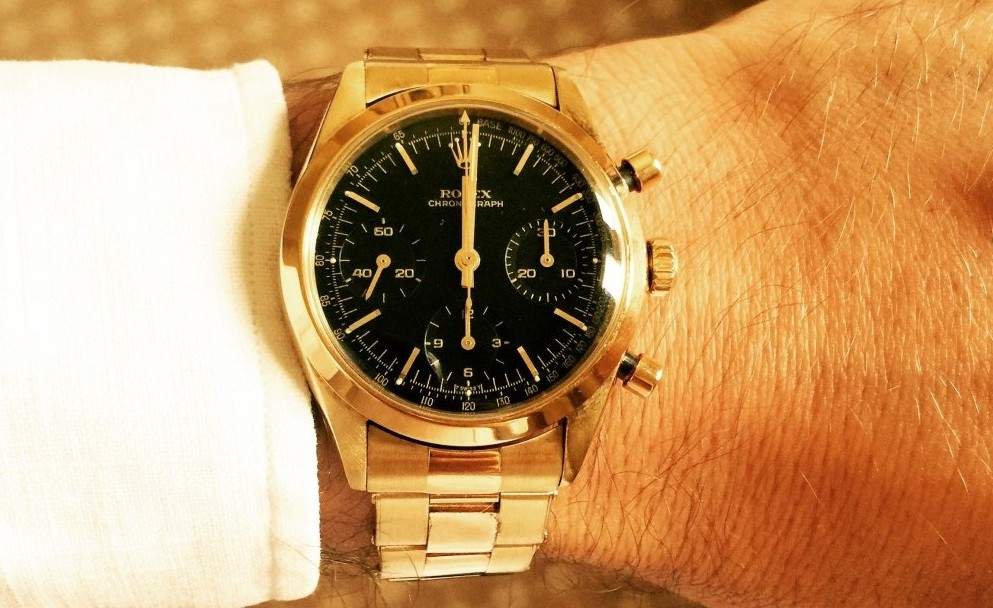
Introduction on the 6238 Rolex
The pre-daytona or 6238 is a fascinating model for many reasons.
First and most importantly- I think it is absolutely stunning.
Secondly and this is the main reason for writing this report, hardly anything is known about the 6238. While tons of literature has been devoted to the Daytona – not much has been written on the Pre-Daytona. How long was it produced for? How many different dial variations exist? The point is: Up until now there has not been one decent report on this beautiful series. Which is kind of crazy right? I mean here we have the watch that would serve as direct inspiration for the legendary Daytona and yet hardly information is available.
It is not that collectors do not value the Pre-Daytona financially speaking. On the contrary, they do. Already back in 2005 models of 6238 Pre Daytona were going for a lot higher than any Paul Newman Daytona model. And still today very rare models of the Pre -Daytona 6238 (like the black dial 14k gold -see main picture above) are more valuable than almost all Daytona. Paul Newman included.
It is this discrepancy that I find bizarre – collectors love the pre-daytona, value the Pre-Daytona in terms of paying high prices, yet not much has been written about this watch. Maybe up until now the 6238 has been a model for the connoisseurs, the high-end Rolex collectors who have done their homework for beautiful, historically important and rare models. It was if you like ‘an insider secret’. Only real Rolex aficionados and connoisseurs knew about it. But I think its time to bring the 6238 into the limelight. With this report I hope we can better understand this rare chronograph Rolex and give deserved credit (at least as press coverage is concerned) to this stunning reference.
For the Pre-Daytona 6238 serves as the perfect bridge between the past Rolex chronographs of the 1950s and the future – with the Rolex Daytona 6239 launched in 1963.
Background information on the 6238
What makes Rolex collecting so addictive and fun is that many variations exist. So mastering the details becomes time consuming and a never -ending process.
To understand the 6238 in its form above (main picture) we must first look to the first variations of the 6238 which looked nothing like the watch above. Rolex introduced the 6238 in 1961/62 with a first series that looks almost exactly like the reference before the 6238 – the 6234 (see picture below).
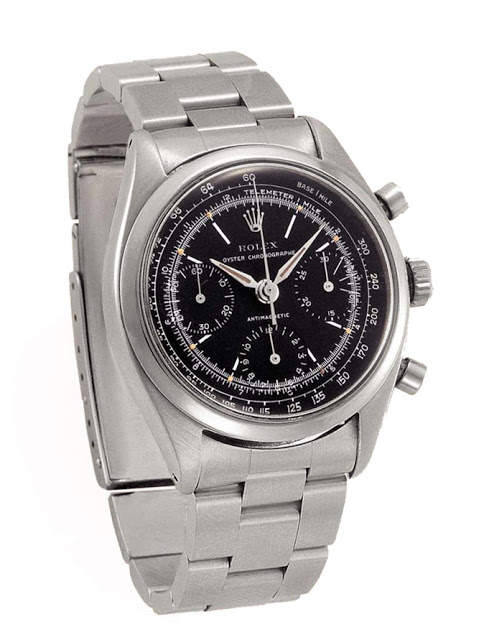
(Credit: Goldberger-model of the 6234)
After the stunning 6234 (see here for an underline version), Rolex introduced the 6238.
Many term the first 6238 version a ‘transitional dial’ as it was a transition from the 6234 to the 6238 (see picture below). The ‘dagger’ hands are taken from the predecessor, the 6234, as is the signature under Rolex ‘oyster chronograph‘ and ‘anti- magnetic’ signature above the six o’clock sub-dial (btw a really fine 6234 just sold at Phillips for CHF 220’000 in May 2016 – see watch here).
With time the 6238 would gradually morph into the last series 6238 with baton hands (which would be present on all subsequent Daytona up until the 1980s) and chronograph only signature and no reference to anti-magnetic. The movement would also change for the 6238 from the 72B Valjoux movement found on the first 6238 to modified movement Rolex would make to the Cal 722 (source Christies). According to most reliable sources (Christies, Mondani), the Pre-Daytona 6238 was made from 1961/1962 to 1968.
What collectors sometimes forget, is that the 6238 was being produced at the same time as the legendary Daytona 6239.
Even in the catalogues of Rolex, they feature both watches together the 6238 and the 6239 Daytona. There can be no denying the influence of the 6238 on the Daytona – it is enormous! The case size, the baton hands, the plexi, the pushers and the winding crown – all are exactly the same for a 6238 and the first Daytona – the 6239.
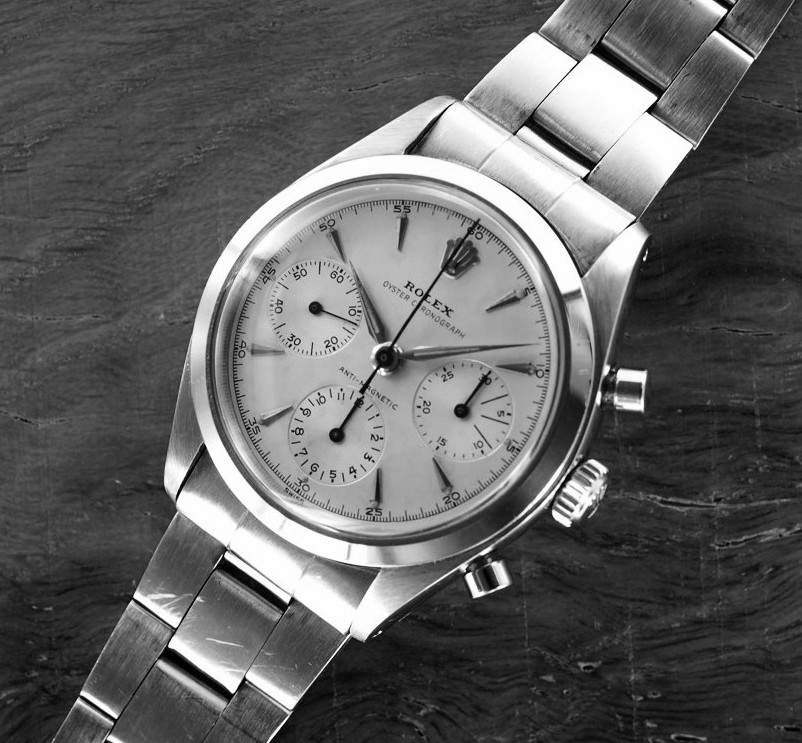
Transitional reference 6238 (Picture Credit: Chanosky)
Lets take a look at the various dial and metal variations of the Pre-Daytona 6238.
- Transitional dial, Oyster chronograph signature antimagnetic, dagger hands, early 1962
- Transitional dial, Oyster chrono, antimagnetic, dagger hands, made for US mkt, 1962
- Silver dial, steel case, Chronograph only signature, baton hands, middle 1960s
- Grey dial, steel case, Chronograph only signature, baton hands, middle 1960s
- Black dial, matte, steel case, Chronograph only signature, baton hands, middle 1960s
- Black dial, glossy, gilt, steel case, Chronograph only, baton hands, middle 1960s
- Tropical, glossy, gilt steel case, Chronograph only signature, baton hands, middle 1960s
- Pulsation dial, steel case, pulsation dial, Chronograph only signature, baton hands
- Silver dial, 18k gold case Chronograph only signature, baton hands middle 1960s
- Black dial (glossy), 18k gold case, Chronograph only sign, baton hands, early to middle 1960s
- Black dial (graine, matte), 14k gold case, Chronograph only sign, baton hands middle to end 1960s
- Black dial (glossy), gilt, steel case, Chronograph only sign. Daytona sig. Early 1960s.
- Black dial, steel case, Rolex only signature, 1963/64.
- Black dial, steel case, Rolex only signature, dial similar to Daytona layout.
(Credit pictures: 1 Chanosky; 2 Dewitte 3 Gerber; 4 Watchesinrome; 5 Christies; 6 Manuel D; 7 Wulf S; 8 Goldberger; 9 Eastcrown; 10 Goldberger 11; Christies; 12 Golberger, 13 Christies; 14 Iceman – Hendra.)
A short comment on the dial and case variations summary above.
While there are many beautiful early series 6238 with transitional dials and dagger hands (like 1-2 above) – I chose to concentrate on the later or second series 6238 with baton hands.
The most well known the later series 6238 is the Nr 3 listed above, a 6238 with silver dial and baton hands. Although the 6238 series is a rare watch (exact figures are elusive, it is estimated that only 2-3’ooo pieces were made of this reference) the silver dial 6238 Pre-Daytona is the most common version seen today. Some of these watches had Tiffany signed dials or FAP (Fuerza Area Peru) Peruvian Airforce signed. Collectors value the silver dial normal 6238 for its simple harmonious layout. It is an understated watch and the watch appears relatively often at international auctions. Although the steel watch silver dial is the most common – I find the watch extremely attractive and well balanced.
Very uncommon and elusive remains the grey dial (right watch -picture below), it is very rare and collectors often confuse it with the silver dial version. Grey dial 6238 steel fetch a good 20-30% premium over silver dial watches. For a good comparison between the difference of a silver and grey dial please see the picture below.
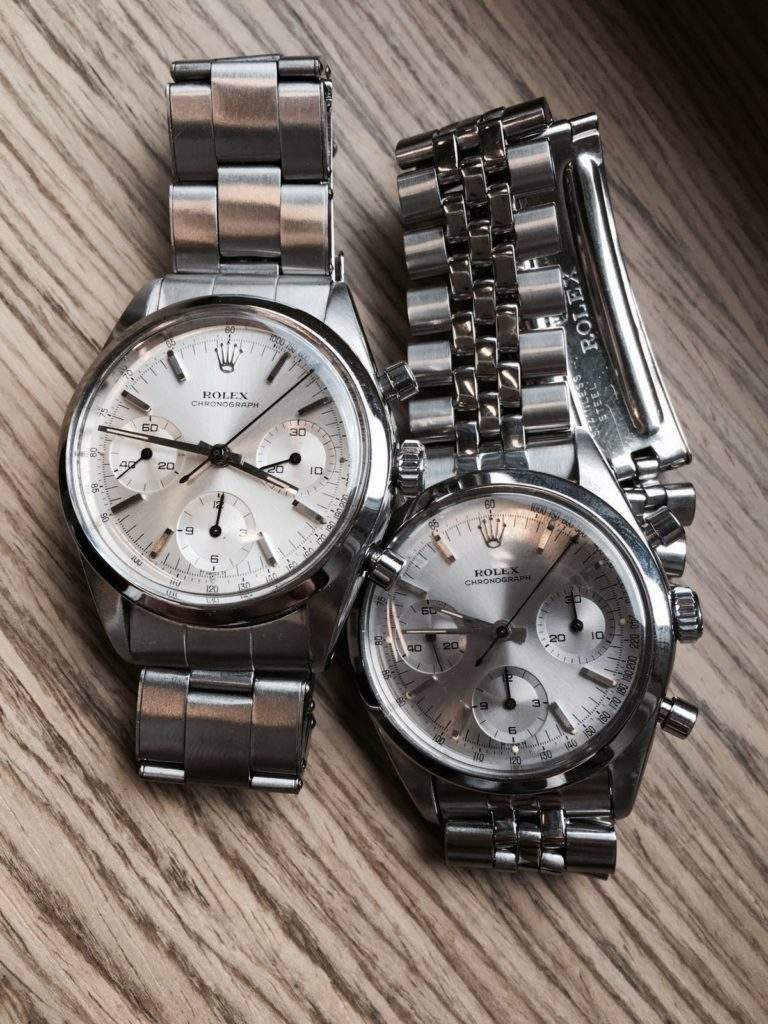
(Credit: Teddy Dewitte).
Higher on the collector desire list is the black dial steel 6238.
This presumably has two reasons. First the black dial watch is striking in terms of appearance but also it is extremely rare relative to the silver dial version. We wrote about this watch already back here. Christies in November 2015 just auctioned a fine black dial 6238 for $100’ooo and the strong price once again confirms collectors interest in this 6238 (see Christies watch here). Just recently, in May 2016 – the 6238 black dial achieved a new world record of CHF 149’000 at Phillips (the watch was also chosen as the cover lot of the catalogue) see details here. Even more rare is black glossy* dials and gilt writing – most black dials are more ‘matte’ in nature. Again here the glossy gilt writing dial 6238 fetches a premium over the normal black dial watch (which is rare in itself). For a hyper rare example of black dial, glossy and gilt – see picture here. Perhaps even more rare is the black dial gilt writing turned tropical – I have only ever seen one watch (example here). This watch is owned by a Middle East Collector.
But the undisputed king and holy grail of the 6238 entire series is the black dial, 14k gold version (with either matte or more glossy dial – the latter being the most rare). The striking contrast between the gold case and black dial with gold print writing is a visual orgasm (excuse my enthusiasm) and it sits at the very top of the pyramid in terms of desirability. This watch will also be the focus of our report. The most unusual and rare version of the entire 6238 family (of which I only know one exists) is the ‘Pulsation dial’ which is also in John Goldbergers book of 100 superlative Rolex watches. Below a nice picture of four different 6238 pictured all together.
*NB: It is important to note that when we talk about glossy dials in the 6238 Pre-Daytona we don’t mean the same glossy mirror like finish that is often found on early gilt dial submariners. Glossy does not mean mirror like but rather just more shine than the matte dials. This is an important distinction as collectors assume that the Pre-Daytona was glossy like the submariners. They were not. The texture of the dial is different.
(Picture credit: Eastcrown Japan)
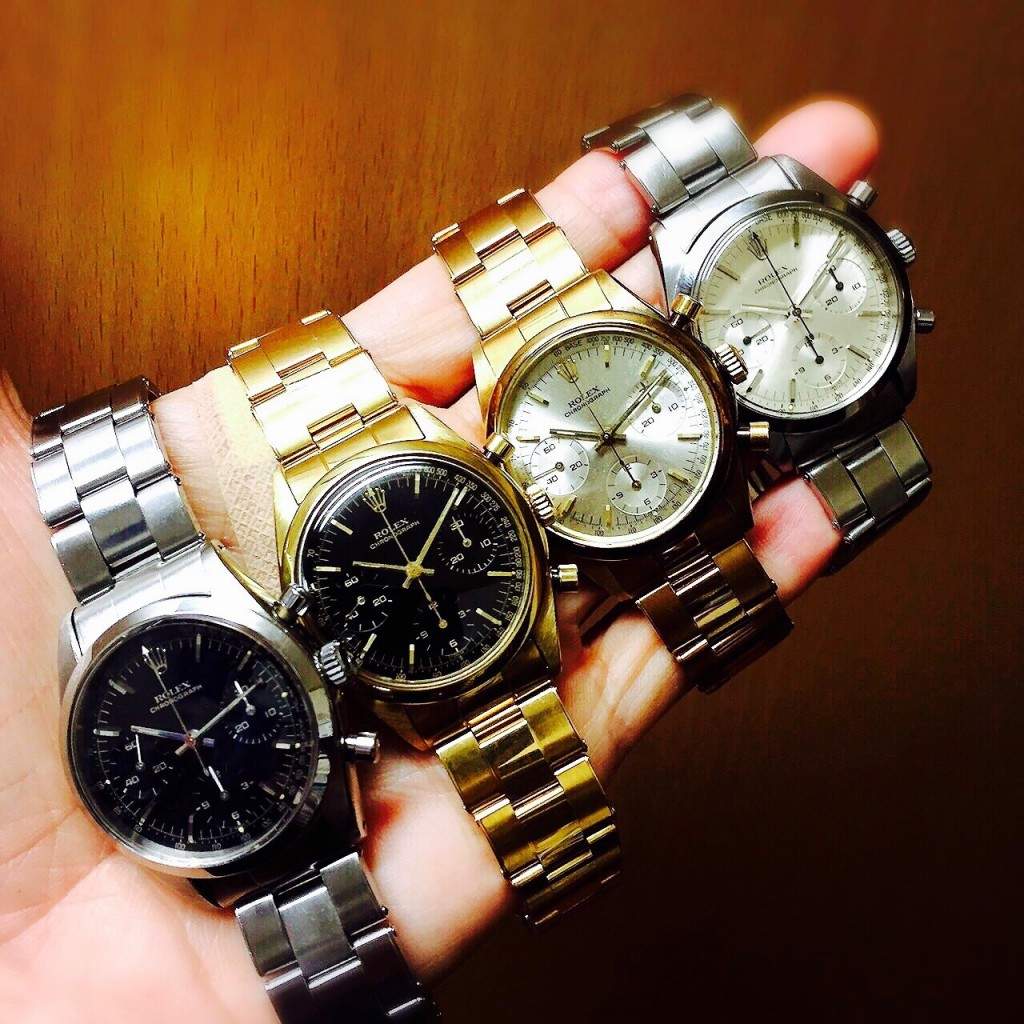
Dial of the 6238 late series model
Why is the last series 6238 so timeless in my view?
Look at the hands of the 6238 below. They are termed ‘baton hands’ by collectors. These very hands, introduced with the 6238 would stay on the Rolex chronograph for another 25+ years after they were introduced in 1960. All the subsequent Daytona models 6239, 6240, 6262, 6264, 6263 would carry these hands. But the first to introduce them was the 6238. They have a more timeless and modern look than the predecessor 6234 and first series 6238 which would carry ‘dagger hands‘.
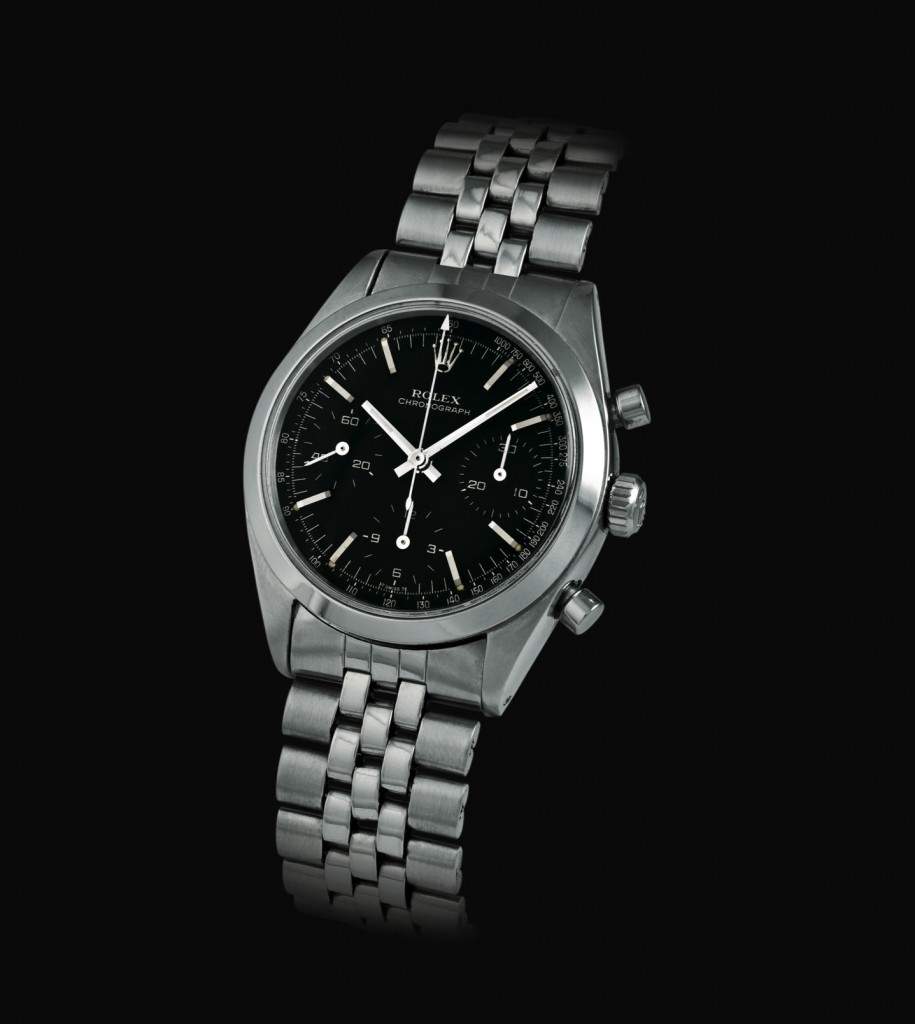
(Credit: John Goldberger)
The dial with the printed tachymeter scale is also a marvel. This is the main reason I admire this watch so much.
It would be the last time Rolex would print the tachymeter on the dial – with the Daytona 6239 the tachymeter is found on the steel bezel directly (which while easier to read for the racing driver) is much less attractive in my view. The polished bezel of the 6238 has something pure and beautiful about them in my opinion.
What is clear is that the dial with integrated tachymeter scale is much more complex to do. It was presumably more expensive for Rolex to carry out this dial than the dial found on the next generation chronograph the Daytona, which had plastic or bakelite inserts (I hear both were used, and from my understanding bakelite is a type of plastic) starting with the 6241.
The 6238 below and the main focus of this report with the gold writing on the black dial is striking in appearance and highly attractive. The dial on this particular watch in the report is also known as matte or ‘graine’. The collector should note that two dial variations existed for the 6238 black dial regardless of case metal, a matte dial and a more glossy dial. Both versions are correct for this model.
What is interesting is that with the Submariner gloss dials came first and would be replaced by matte dials in the second half of the 1960s. But for the 6238 the order is not that clear. Some matte dials are also found relatively early on in the 6238 last series production. For example the nice Christies 6238 black dial just auctioned in November 2015 carried a serial nr 1’166’xxx and was dated 1964 with a black matte dial (see picture here). It thus seems that glossy and matte dials were made throughout the 1960s with the 6238 in no particular order.
Just for your pleasure another beautiful 6238. This was a gilt glossy dial that turned tropical- a very rare version of the 6238.
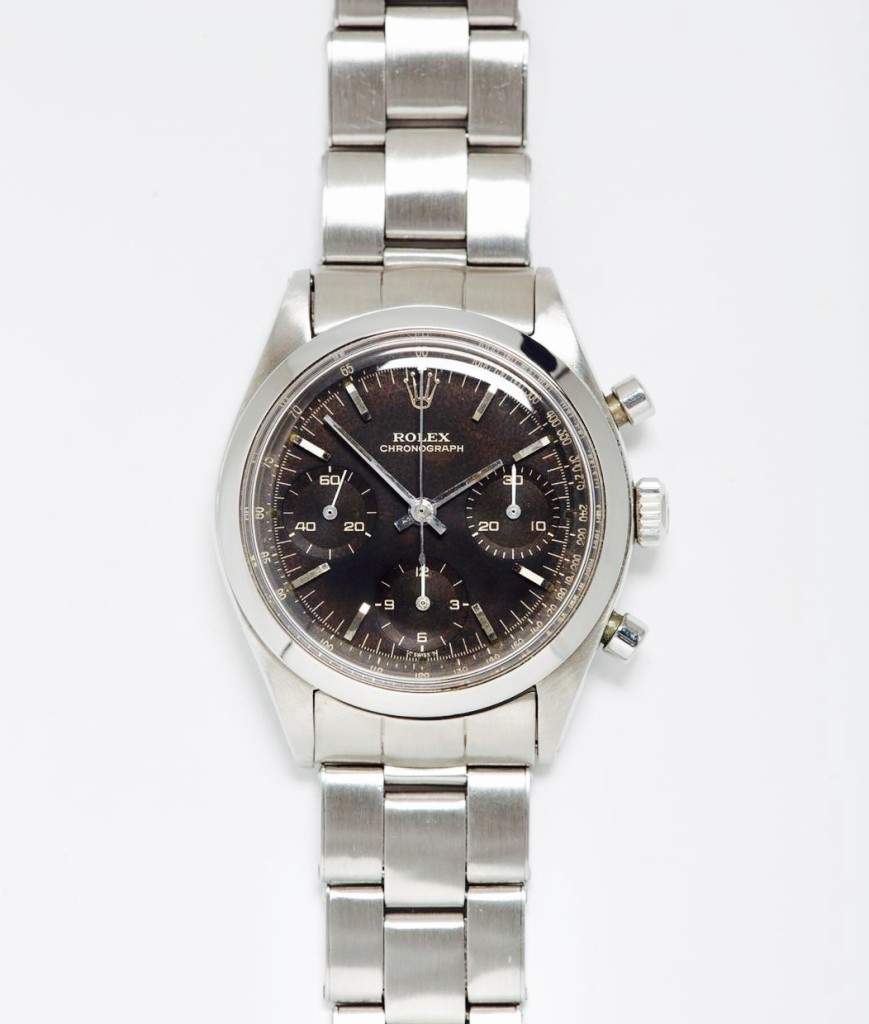
(Credit: Wulf S – Rare & Fine) Notice the ‘-T Swiss T-‘ at the bottom of the dial.
Hands & Dial of the 6238 late series model
A short comment about the hands of the 6238. There is some controversy as to what the correct hands are. Yes, of course they are baton hands in shape for the later generation 6238. But the controversy is over the length of the hands. Look at the picture below. Do you notice something?
The minute hand extend over the lines of the gilt print minute marker scale. Would Rolex ever make hands that extend towards the outer scale of the dial? While many say very unlikely (including myself)- it could be correct nonetheless – for several reasons.
First a longer minute hand is also found in the Goldberger book (see black dial picture here). Now while even a John Goldberger could be wrong- I would argue he is far more often right than wrong. I greatly respect his knowledge and will take it as a vote of confidence that the long minute hand is in his book. Having said that – it should be mentioned that Goldberger also has the shorter minute hand in his book (for example the Gold 6238 that he shows in his book is the shorter minute hand version).
Secondly we must remember that both references 6238 Pre-Daytona and the 6239 Daytona were in production simultaneously. Possible that some last batch 6238, like this model in the report, left the Rolex factory with longer hands. (I personally think the correct hands should be shorter like this picture here)*. More on this topic later.
In addition to the elongated hands – you can see the wonderful tachymeter scale on the dial directly in the picture below. It is a piece of art.
*Credit: J Gerber
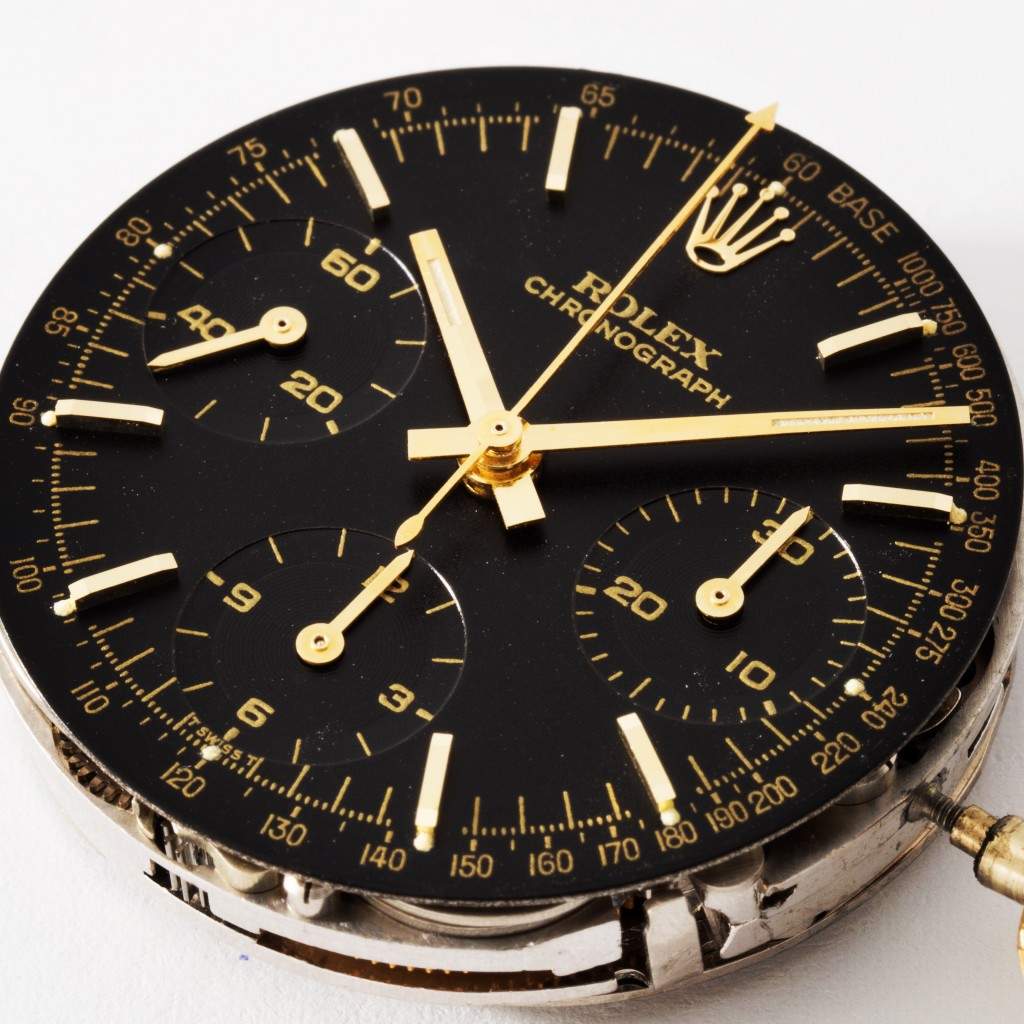
Below at the six o’clock register the watch is signed T swiss T (see picture below) which is also similar to many Daytona models that would come after including the 6239. Even the layout of the subdials would remain the same with the next generation chronograph as would the position of the lume plots on the dial. The T swiss T absolutely correct for the time period (1968) and would denote that the luminous on the hands and hour markers were made out of tritium and not radium.
What is extremely interesting to note and something I just recently learned and wanted to share with you is the following – this applies to black dial steel watches only. Apparently according to one collector (who I trust) the correct dials all carried the ‘-T swiss T-‘ at the bottom and not just ‘T Swiss T’. He explained that it could be – that all dials carrying just ‘T Swiss T’ without the minus signs are very early correct Rolex replacement dials. Again this is just another piece of information that I found out and we have to treat it with some caution – as with all new information we learn about Rolex. But I thought I would include it in this report for what it is worth. At this time and with the information I have – I am not sure if this dial information applies to silver dial/steel watches.
For an example of the ‘-T SwissT-‘ see the pictures of the tropical brown above. The collector told me it does not apply to gold watches. Looking at numerous gold watches 6238 with black dials and silver dials I have to think he is correct – gold watches had only ‘T Swiss T’ signed on the dials from what my research can find. Evidence from the Goldberger book and other research including seeing a gilt glossy version of the 6238, by a well known Japanese collector/dealer supports my theory. All Gold 6238 with black dials came with the ‘T SwissT’ only.

A comment on the subdials
The sub-dials hands is another important topic among 6238 collectors, scholars and owners.
Although the sub-dials themselves would not change much with the next model, the 6239 Daytona – what is different on the Pre-daytona are the sub dial ‘hands’. They are thinner than on the next model the Daytona and look almost ‘stick’ like in form. In fact on this gold 6238 – in my opinion the sub-dial hands are NOT correct and taken from the Daytona. They should be thinner in form much like the hands you see on this picture here.
(Credit for both pictures above: P Boutros for Phillips).
Case, case back and movement of the 6238 late series model
The case size of the 6238 late series is 36mm a good size case. If you combine the relatively large size together with the baton hands it explains why the 6238 has such an enduring appeal still today.
The next generation chronograph, the Daytona 6239 would retain the same size case, the same pushers, the same hands (except for the sub-dial hands-they would get larger on the middle and right sub-dial).
Below a nice view of the case. Notice the polished bezel – the last time Rolex would have that – the next watch – the Daytona would have the tachymeter scale on a separate piece of plastic/ bakelite – then inserted on the bezel. I personally like the polished bezel which reminds me strongly of the Explorer watch line. Furthermore the case on this particular watch is a 14k gold case (the watch was also made in 18k). The 14k gold case was reserved exclusively for the US market and is also the most rare case variation found on the Pre-Daytona 6238 series (most of the watches were cased in steel and only a few in 18k gold).
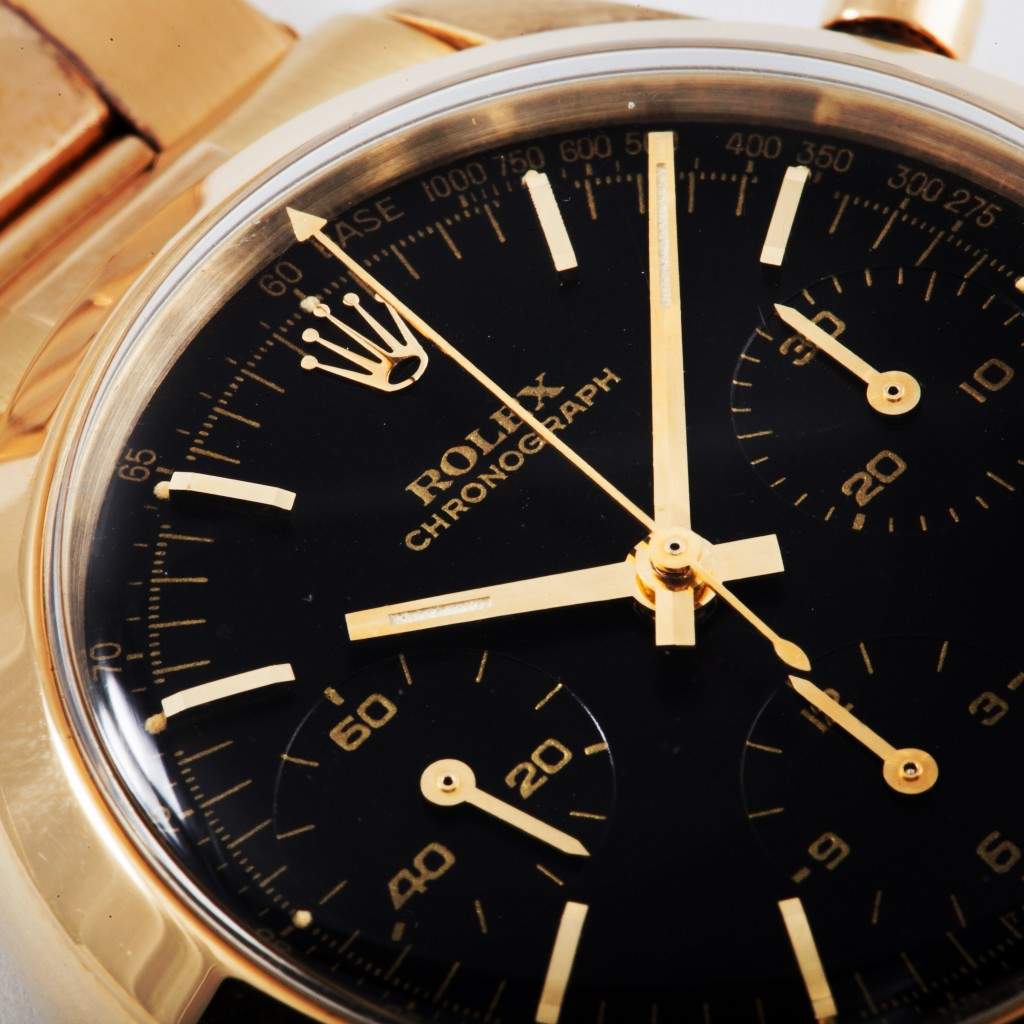
Another view of the case and pushers can be seen below.
This watch obviously has been sitting in a safe for a good parts of its life, the oxidation can be seen clearly on the picture below. The pushers would remain exactly the same for the 6239 Daytona which would replace the 6238 pre-daytona and only with the 6240 would have screw down pushers.
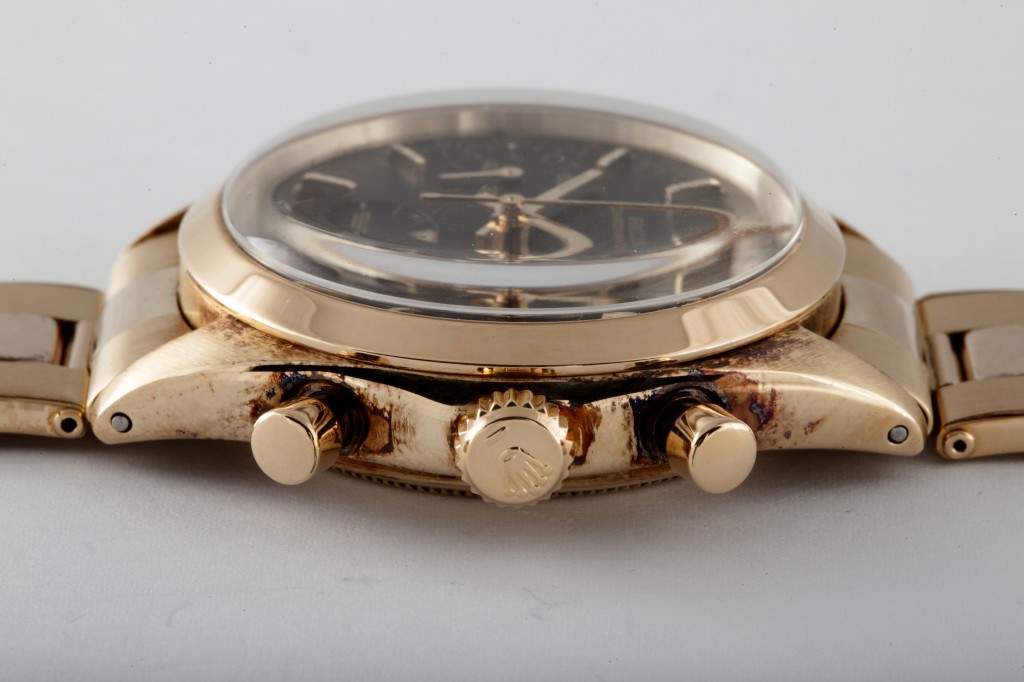
(Credit for both pictures above: P. Boutros for Phillips).
The inside case back of the 6238 is quite standard Rolex. The Rolex model is clearly written as is the fact that it is either 18k or 14k (in this case 18k – note this case back belongs to an 18k watch and not the watch in this report which is a 14k version). What is interesting to note is that the date of production which is often found on Rolex submariners is absent from the Pre-Daytona.
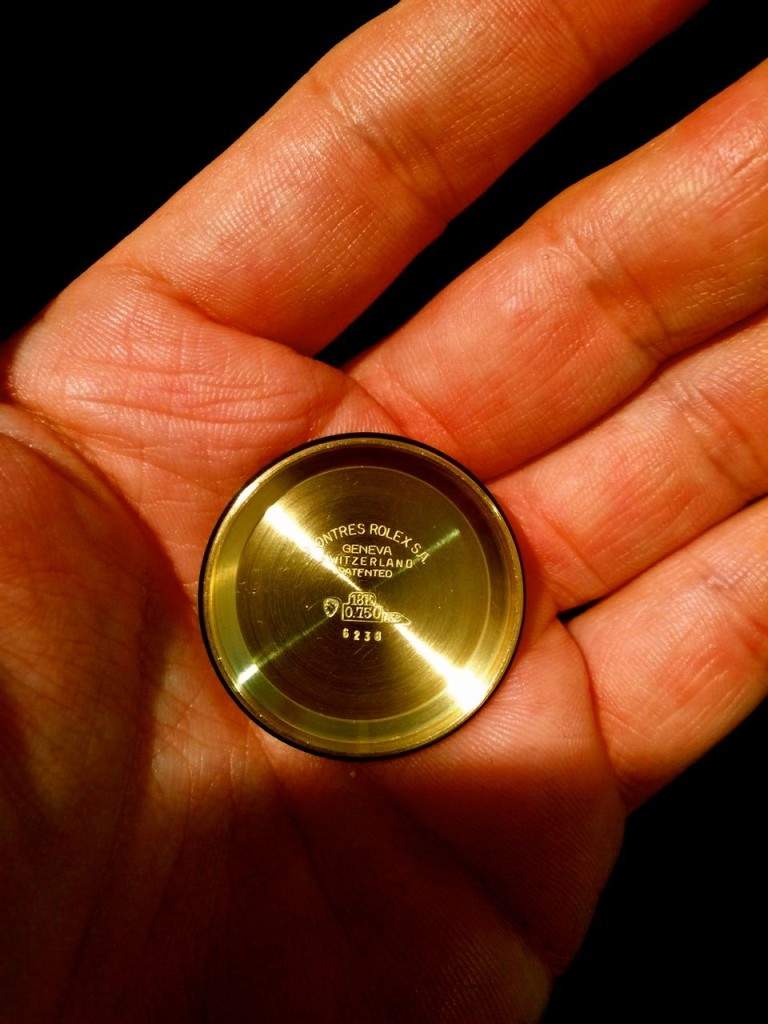
The movement found on the 6238 Pre-Daytona last series is a 722 Valjoux based movement.
It is of course a manual movement and needed to be wound by hand. The earlier series 6238 carried the same movement but it was named 72B caliber (Valjoux would rename the movement in 1965 circa). The Valjoux movements were responsible for powering some of the greatest names in watchmaking which included Patek, Audemars, and Breguet. The Valjoux movement was considered robust and very reliable.
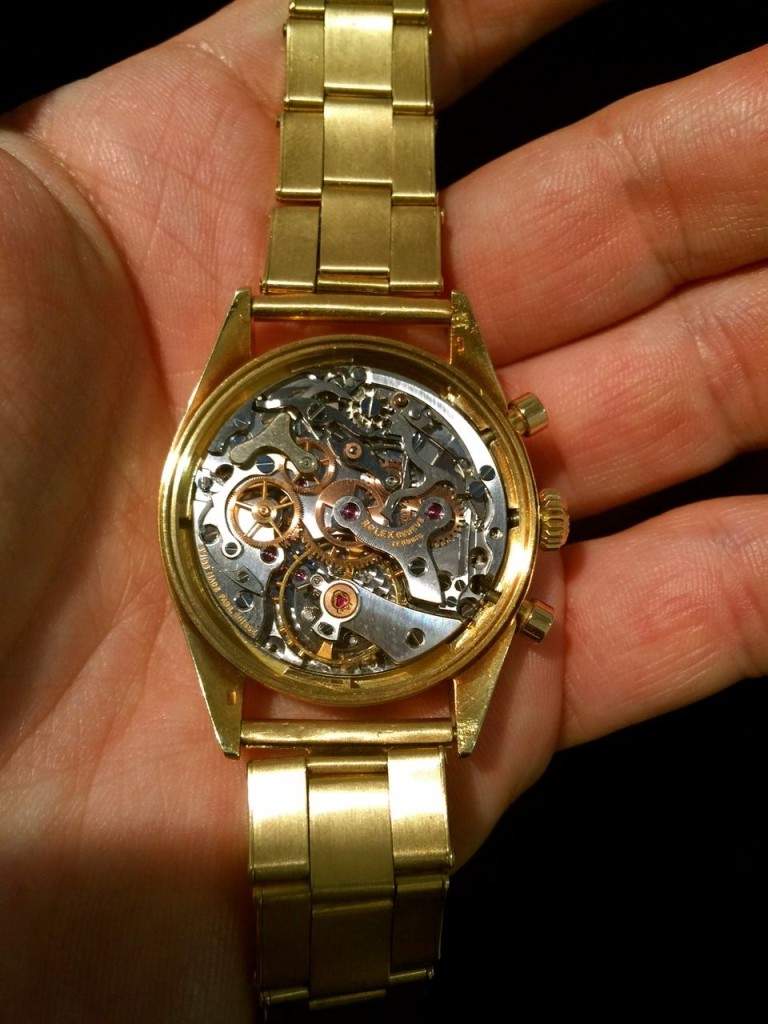
Comment on the price developments of the 6238
I don’t like to talk about prices of watches.
There is a famous saying by Oscar Wilde ‘a cynic is a man who knows the price of everything and the value of nothing’. But since the watch blogs, collectors, auction houses, and collectors love to talk about the value of Daytona – well let’s take a look at the values of Pre-Daytona too.
For it is here where there is large discrepancy between what is found on literature and the reality of the model in terms of prices. Normally the press and blogs do a good job at reporting expensive and rare items but sometimes they don’t (as is the case here). There is no doubt: the Pre-Daytona is extremely highly valued by collectors. More than the Daytona. Even more than the mighty Paul Newman.
Don’t believe me? Lets take a look at the numbers.
Already back in 2006 Antiquorum sold a silver dial 18k gold version that belonged to Mr. Mondani for an outstanding CHF 238’ooo (see picture below) – at a time when Paul Newman were perhaps at best selling for CHF 45 -55’ooo. In 2005 a 6238 gold version 14k (made for the American market like the main watch in this report) with black dial sold at Christies for a record CHF 180’ooo – blowing past the estimates of CHF 90-120’ooo (see details here). In 2008 Christies sold a 6238 silver dial 18k gold for an impressive CHF 180’ooo again blowing past the estimates of CHF 70-100’ooo (see details here).
Do you see what I am getting at? Ever since I can remember the 6238 in rare form (this even includes the sought after black dial steel version) has been fiercely fought after by collectors. More often than not, the prices achieved were higher than the Paul Newman models.
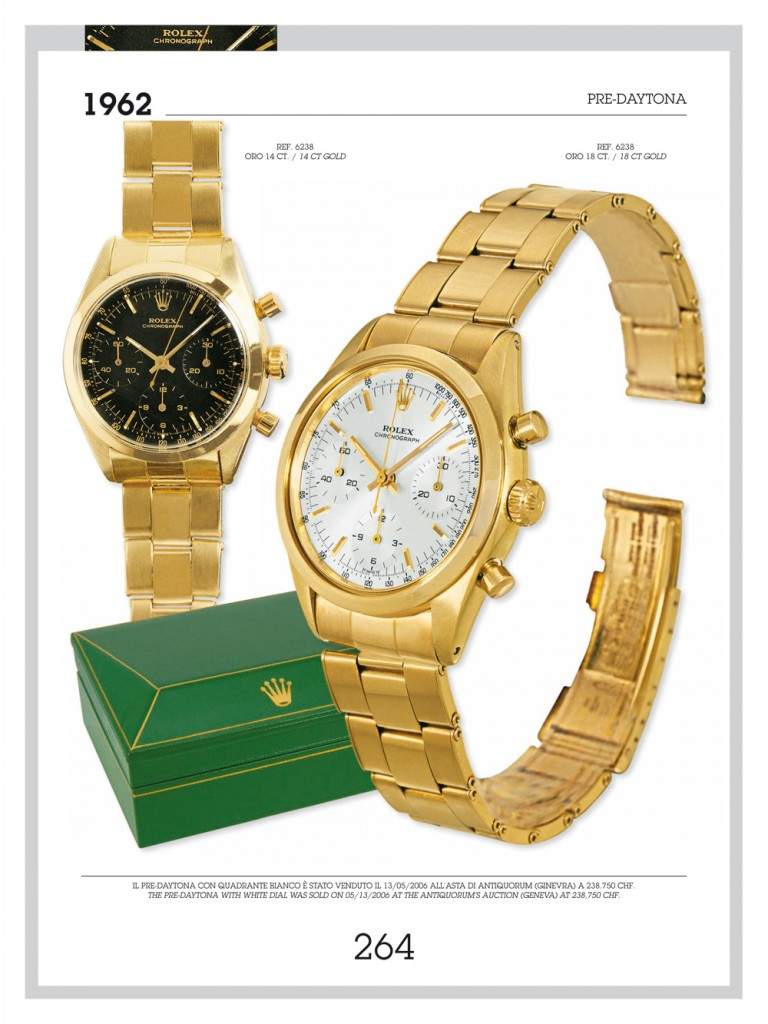
(Source: Mondani)
The situation has not changed today.
Just earlier this year in May of 2015, a collector paid an a strong CHF 317’ooo for black dial gold 14k version – for exactly the same watch that appeared at auction 10 years ago for CHF 180’ooo at Christies. In the Daytona and Paul Newman world only the elusive Oyster Sotto (and an outer minute brown track Panda) can achieve higher numbers. The Pre-Daytona is highly valued by collectors. At least here the watch market is being rational. The pre-daytona is much rarer than the Daytona (including Paul Newman) and the market to a certain degree has recognized this.
Concluding remarks
The 6238 pre-daytona is not for everybody. And that is exactly why it appeals to me.
It is a true connoisseurs watch – for a collector who values beauty, rarity and purity. I love good design and the purity of the pre-daytona (no plastic or Bakelite on this watch) makes it among the most beautiful watches Rolex ever made in my opinion. The integrated tachymeter on the dial and polished clean bezel gives the watch an elegance combined with sportiness (lets not forget this is a chronograph) that is unmatched.
When I walk into a room full of collectors, there are bound to be plenty of Daytona’s. Plenty of Paul Newman. Even the king of the Paul Newman – the ‘Panda’ with screw down pushers – can be found relatively often (its a fact – most big collectors have one). But try and find a collector wearing a 6238 black dial 14k or 18k Gold. Look hard folks because I only know about 5-7 watches in the world that exist (with the correct matching bracelet). Even the 6238 black dial steel is a very rare watch. Just hashtag 6238 on Instagram for proof.
This is why I like the Pre-daytona 6238 in general. It is a rare watch. And forgive me for being slightly arrogant or elitist – I like owning rare things. Besides I also think it is a more beautiful watch from an aesthetic point of view.
I admire the Daytona and have nothing against the model (and sooner or later I will own a Daytona, especially because I am a vintage car collector too – besides the fact that the design is very appealing). Just like I admire and own a vintage 911 Porsche. They made plenty of those too. But when I walk into a room and a collector is wearing a Pre-Daytona – it tells me something about that collector. Perhaps he likes rarity. Or likes the ‘purity’ of the case. Admires clean design. Or maybe he just likes the fact that its a Rolex that is known ‘only among the very few’. The very few who know.
NB: Please see important pictures below which is very useful information for the 6238 collector as well as some more comments on the hands of the 6238.
No report would be complete without a few wrist shots.
Here a wrist shot of the 6238 second series with black dial (credit: Khalid AM). In my view one the most beautiful chronographs Rolex ever made. The minute hand this time is shorter and does not extend towards the outer scale. I believe this is the most correct version for 6238. Notice the thin stick sub dials – also correct in my opinion for this reference. Notice the ‘-T Swiss T-‘ on the bottom of the dial.
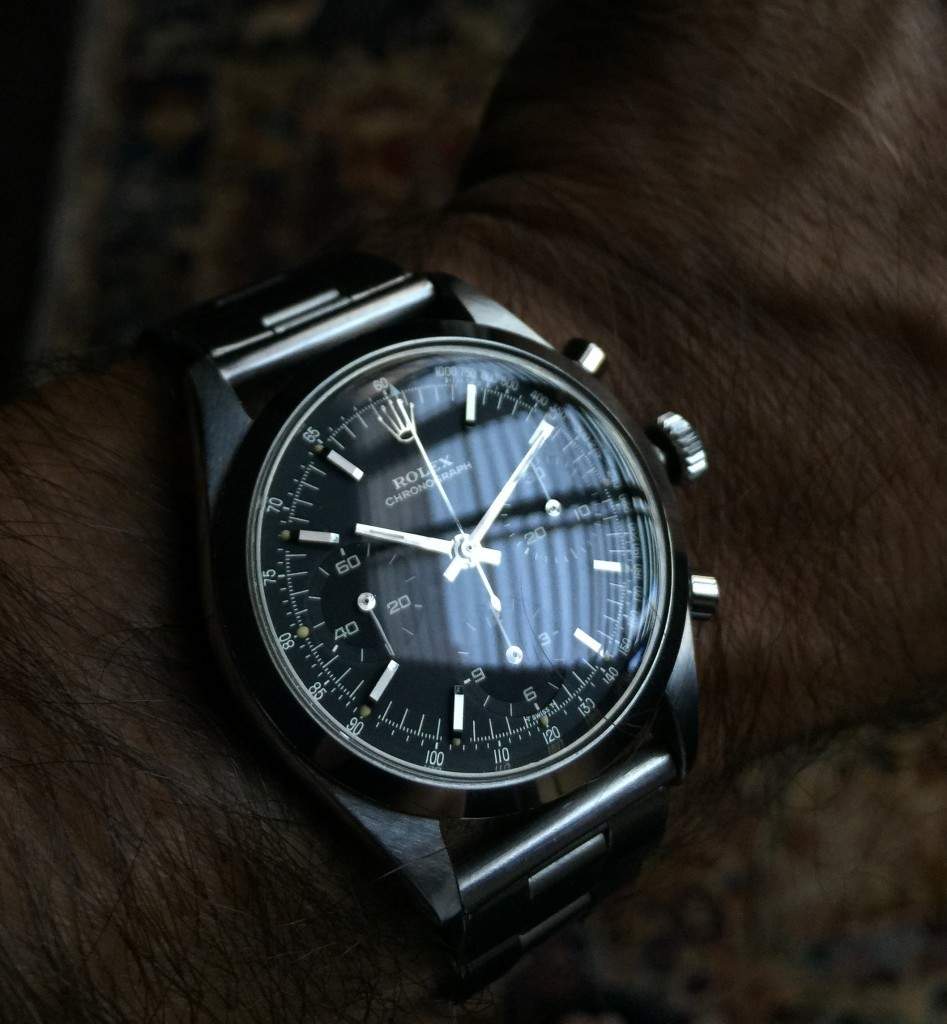
Another shot of the 6238 black dial in natural sunlight. It is a rare watch as much as it is a dream watch. Pure understatement. Here the minute hand extends over the outer scale of the dial. This watch below was once owned by one of the most foremost experts in the world of watches. Once again casting doubt as to what the correct hour hand length might be.
Also notice this does not have the minus signs and is signed just ‘T Swiss T’ on the bottom of the dial.
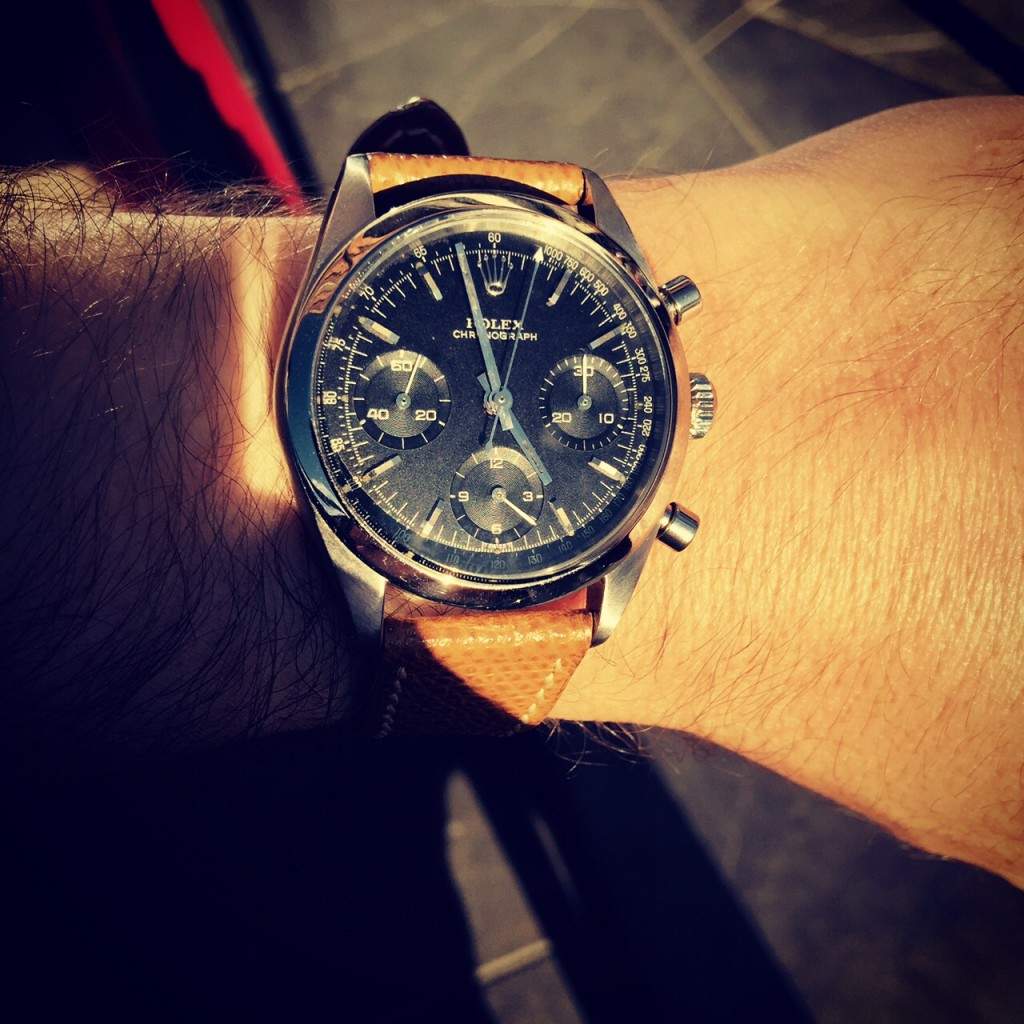
Another wristshot of the rare black dial steel version. Again here the hour hand extends over the outer scale. Notice this watch is without tritium lume. Giving the watch a cool look in my opinion. (Credit: Manuel D). Notice the ‘-T Swiss T-‘ on the bottom of the dial.
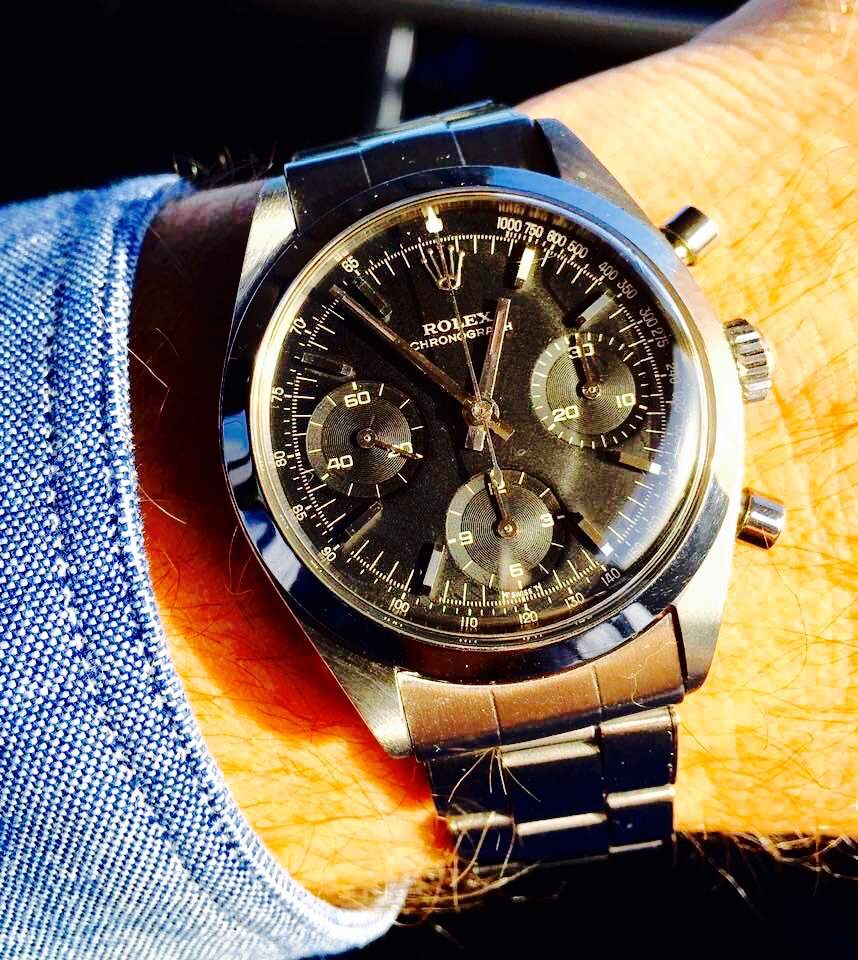
Another picture of this no luminous 6238 Pre- Daytona below. I like this no luminous version (looking at the dial it seems the watch was born this way and is unlikely that the luminous was ever removed). (Credit: Manual D). Notice the ‘-T Swiss T-‘ on the bottom of the dial.
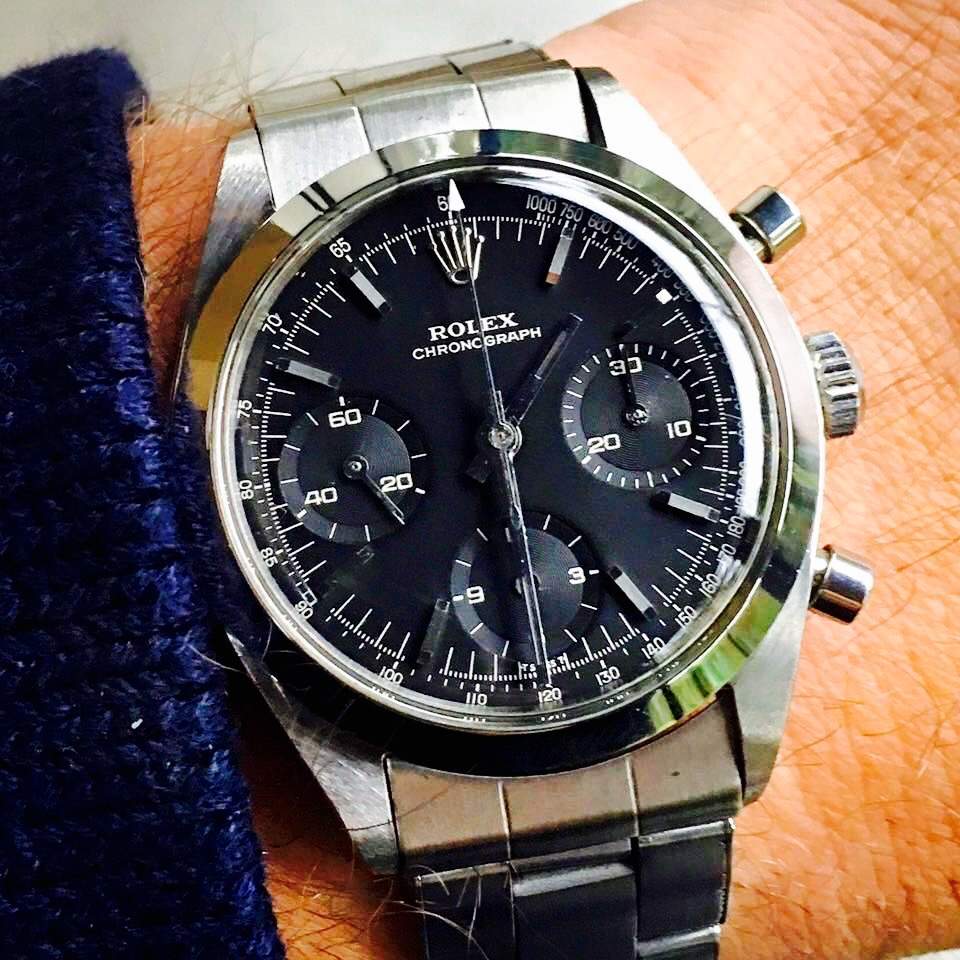
Here a hyper rare and extremely fine and attractive gilt dial 6238. The watch is more glossy than the watch above and thus is termed ‘gloss – gilt‘ dial.
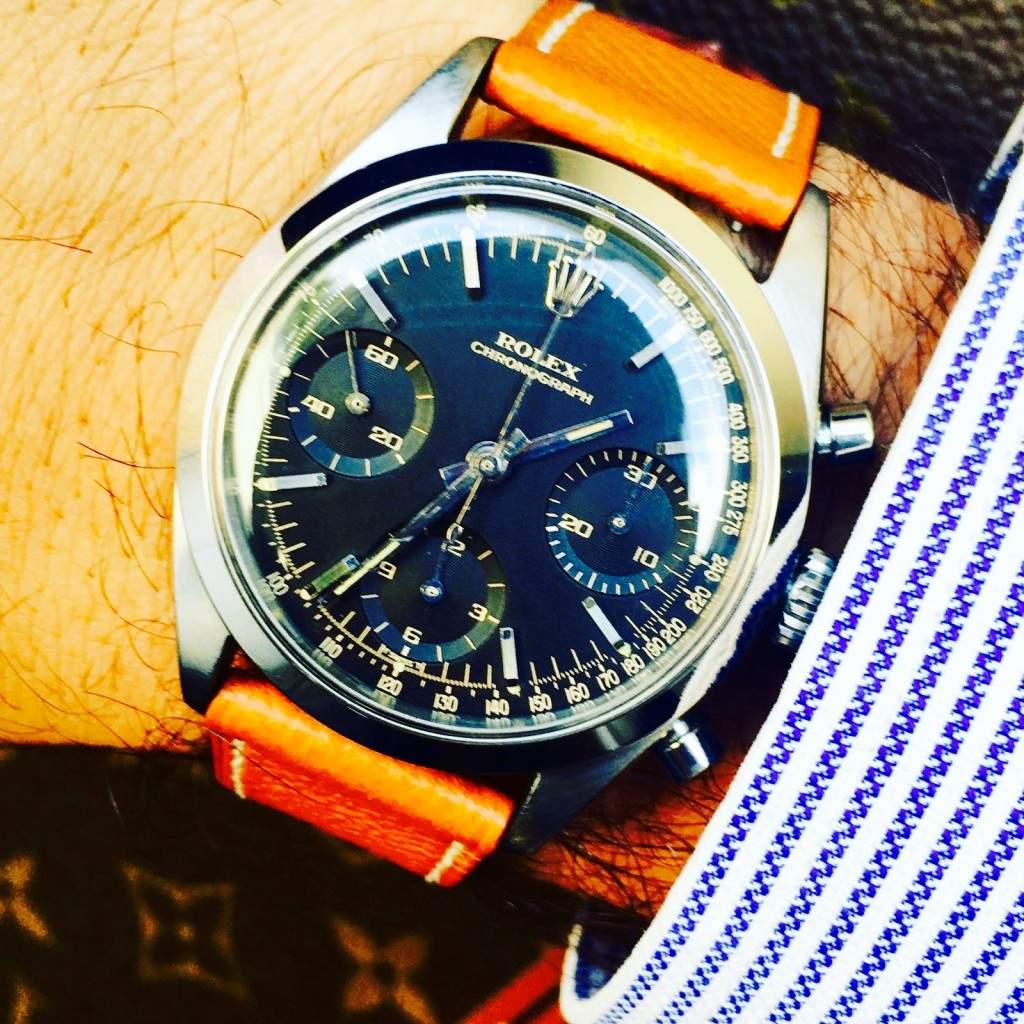
Here a nice matte dial 6238 with original Bucherer (famous Swiss retailer) invoice showing the purchase price of CHF 780. (credit: Stefan).
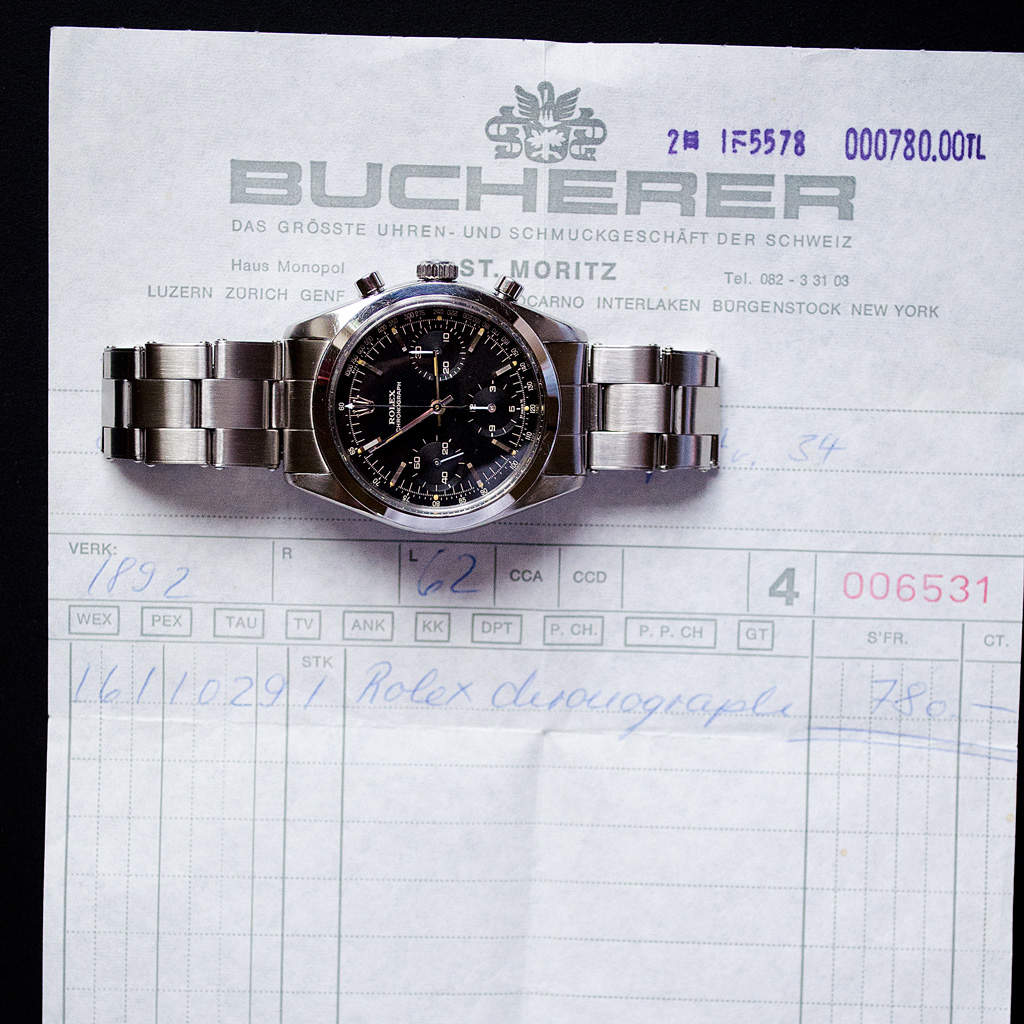
Just for fun another shot of the elusive 14k Gold version with black matte dial. The king of all 6238s. The owner likes ‘knee long’ socks apparently.
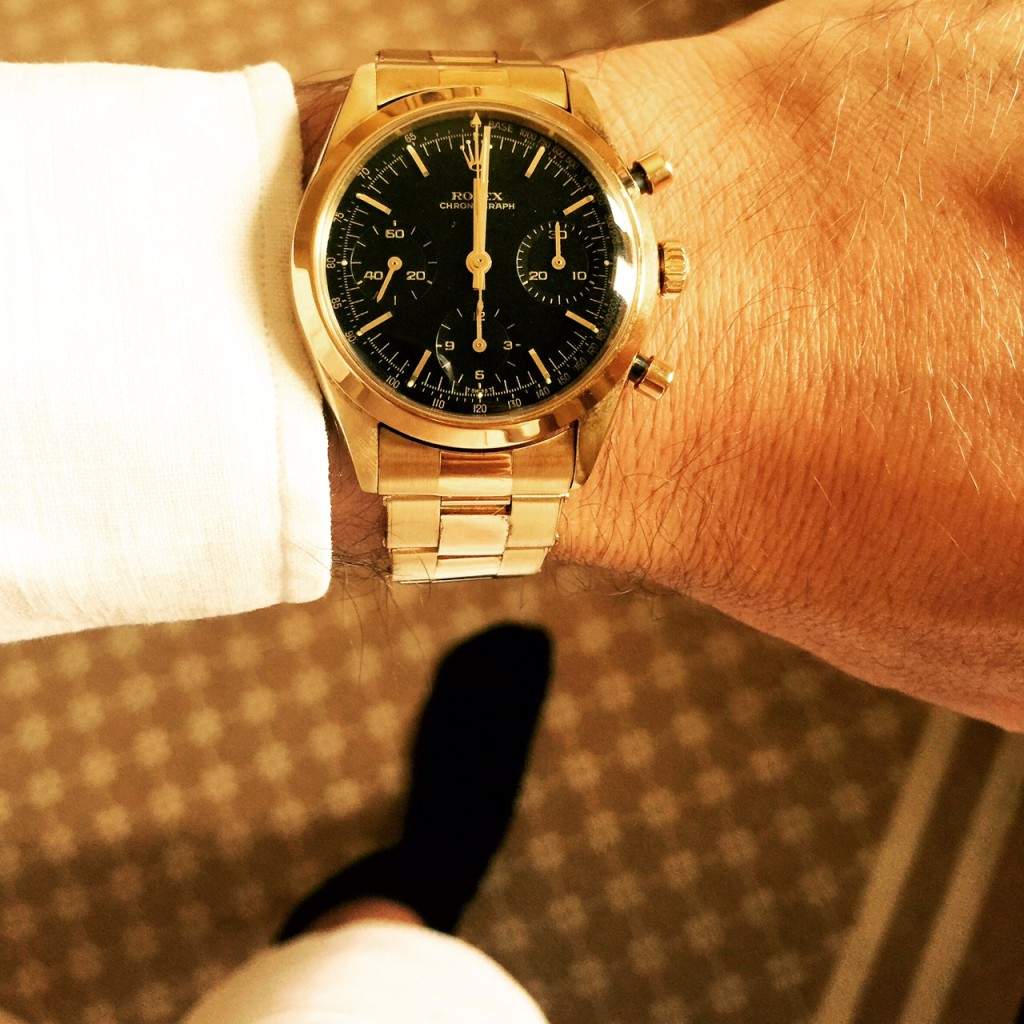
Another shot of the 6238 black dial and 14kt gold in natural sunlight but not exposed to the sun. (Credit A. Touchot)
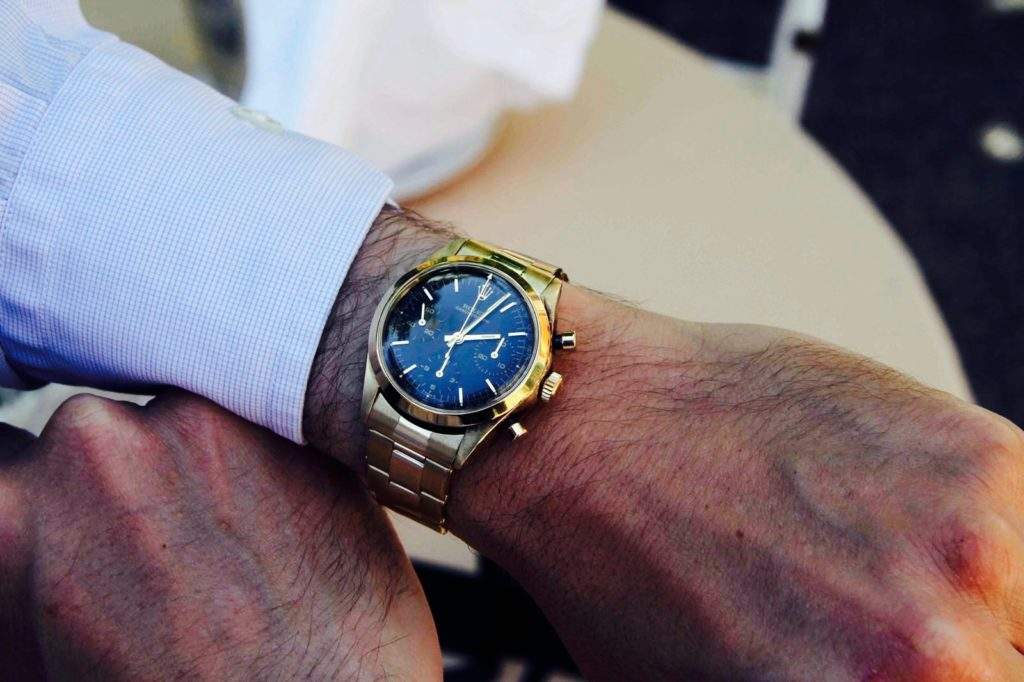
This picture shows the 6238 in 14 kt gold in direct sunlight. The dial is exposed in all its beauty with the gold print and matte dial.
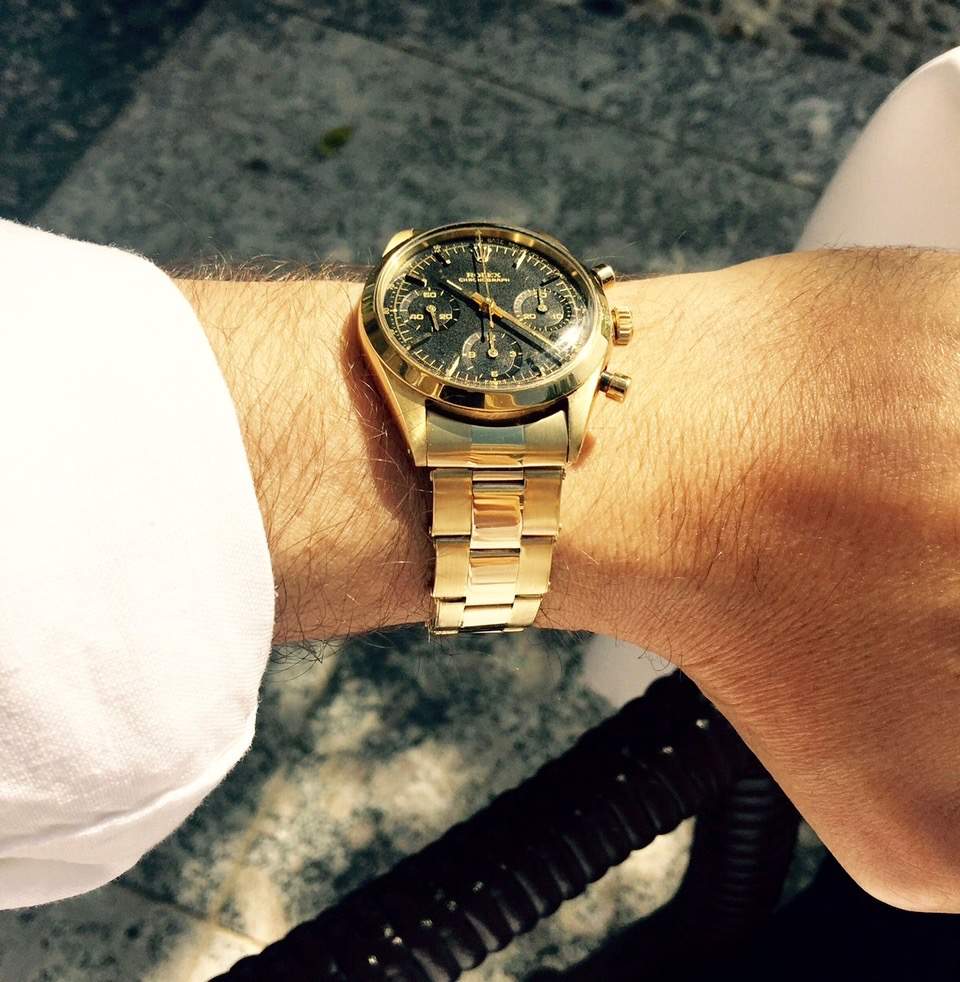
The last picture shows a 6238 gold 14kt with front view of the dial. Together with the gold case – a nice contrast.

Another shot of the 6238 in sunlight.
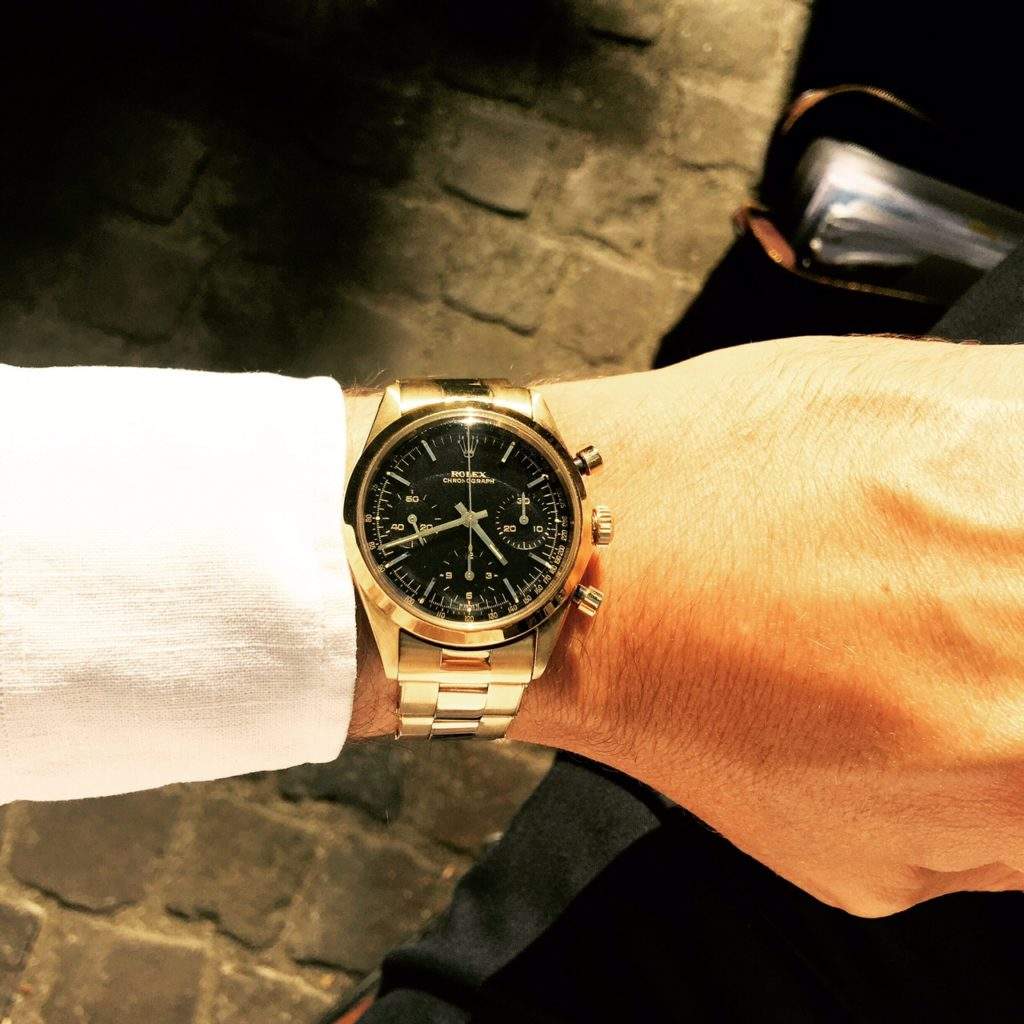
Additional comments concerning the hands of the 6238
I think some additional comments are worth noting on the 6238.
Many 6238 have appeared at auction lately. Some have the extended minute hand over the outer scale but many also do not. It has caused some controversy with 6238 owners and collectors as well as the vintage Rolex community.
Let us be honest. In theory it does not matter if the minute hand is extended or not. If it is correct or not. Even if the extended hand belongs to the next model – the 6239 – it is still a Rolex hand made during the same time period. But Rolex collectors are a paranoid bunch – and obsessive on details. That’s why so many are drawn to collecting Rolex. So lets get into the discussion, no matter how silly and absurd.
The reason for the controversy is that the 6238 Pre-Daytona and the 6239 Daytona were made at the same time. Therefore the last batch of 6238 being made could well have the longer minute hands which were correct on the next model the 6239. For example the Gold watch 14k you see in this report was one of the last 6238 ever made in 1968. Conceivable that the minute hands were taken over from the Daytona now and this is how they left the factory at Rolex. At least it seems a plausible possibility.
Also new evidence has surfaced giving new weight and credibility towards the longer minute hand of the 6238 being also correct. Phillips in their 88 Epic Chronograph sale have chosen a Pre-Daytona on their cover (see picture below). Not only is this a testament to the importance of the 6238 Pre-Daytona as one of the most important chronographs in the world – it also sheds new light in terms of what model they choose. The elusive and very rare black dial model. But. With long minute hands.
Think about this for a moment. The most important steel chronograph only sale that the vintage watch world has seen in at least a decade and for the front cover they choose a 6238 Pre- Daytona. With long minute hands. Surely it must be correct, right?
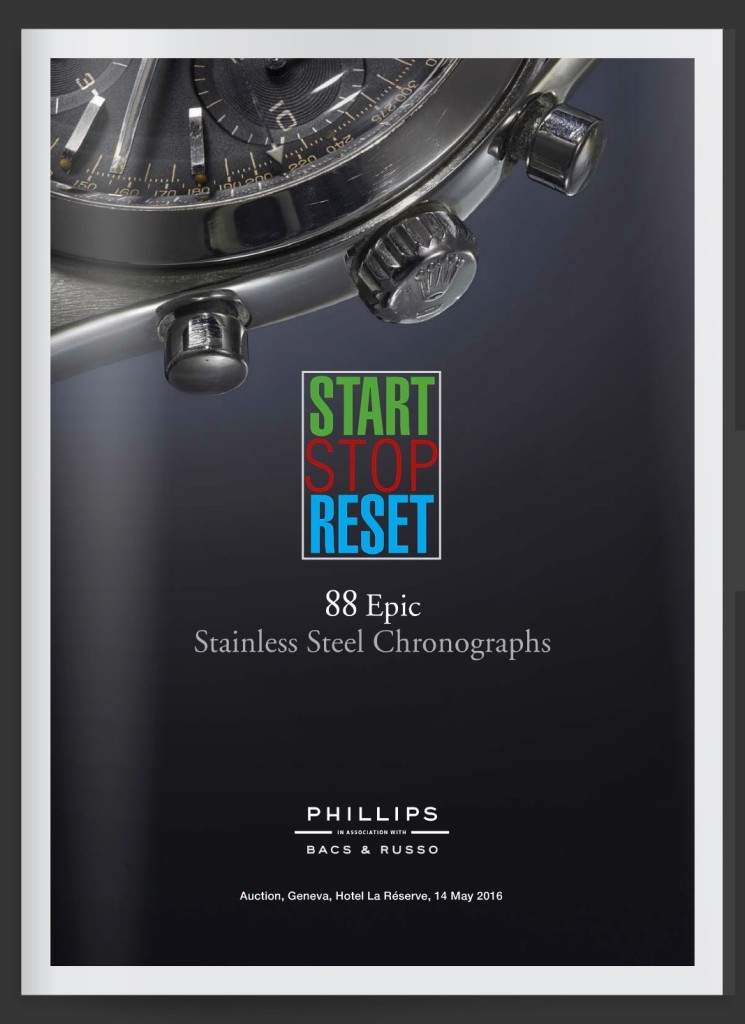
Taking the other side of the coin- we could also argue that the extended minute hand is not entirely correct for the model.
Rather when owners of the 6238 sent their watch in to Rolex it was serviced and the hands were replaced with Daytona hands which were slightly longer and thus would extend over the outer scale with the 6238. This also seems to be a possibility. In my view a very strong possibility.
To continue the argument against the long minute hand being original considering the following. Rolex was a company of extreme detail.
One could argue that Rolex would never have produced a minute hand that extended over the outer scale. It must also be mentioned that the majority of the 6238 have shorter minute hands and optically and aesthetically this seems more correct to me. If I had to place my money on what is right or what is wrong I would argue that the extended minute hand is NOT period correct for the 6238. The extended hands are still Rolex hands, however hands of the Daytona and not Pre-Daytona – so in conclusion really a small detail.
To conclude the line is blurry between pre-daytona and daytona.
Just look at the next few pictures below. This explains how close the 6238 was to the Daytona and really was a transitional period for Rolex. Below is a very rare 6238 with Daytona written on the dial. The dial is also gilt in writing. Only three are known in the world today. Is this a 6238 or a Daytona? There is a very fine between the two models here.
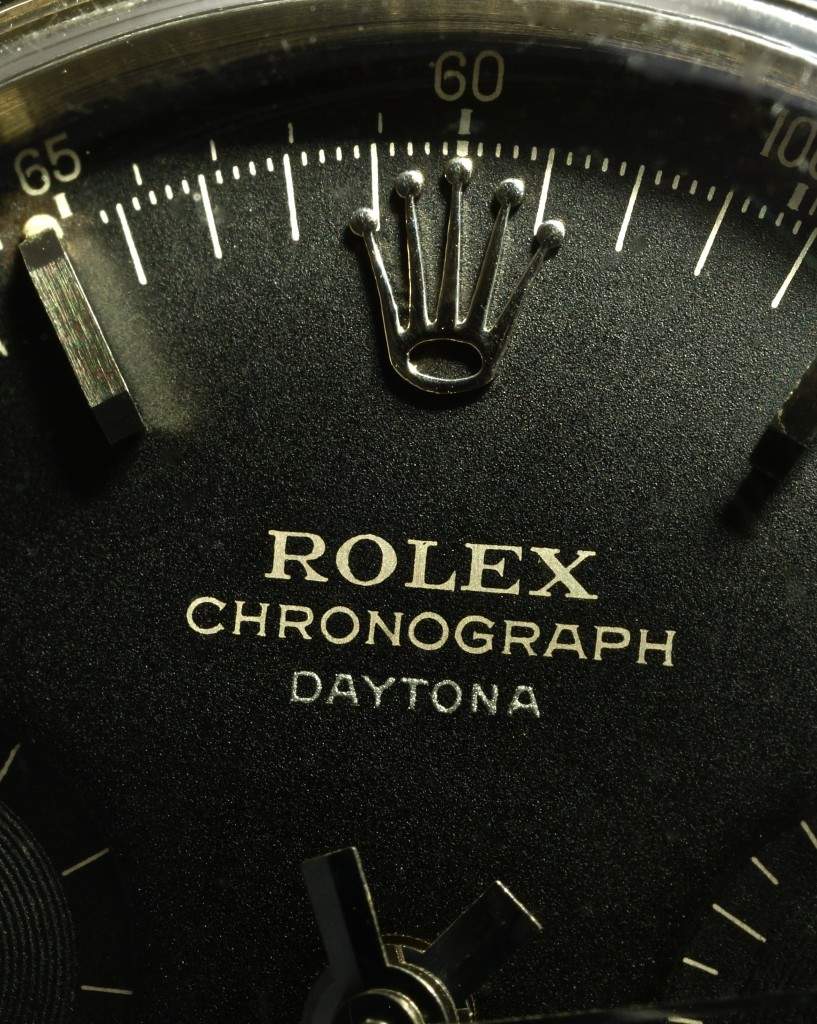
(picture credit: John Goldberger)
Here another picture of this special Pre-Daytona 6238 (same watch as picture above) with the word Daytona on the dial. Here the hands are shorter and in my view the most correct version to belong on any pre-daytona 6238.
Oddly enough the sub-dials hands are not all the same as with most pre-daytona but here we see a move towards the Daytona sub dial hands. The middle and right ones are slightly thicker than the left sub-dial hands – something every noticeable on the Daytona 4 digit model numbers to come after.
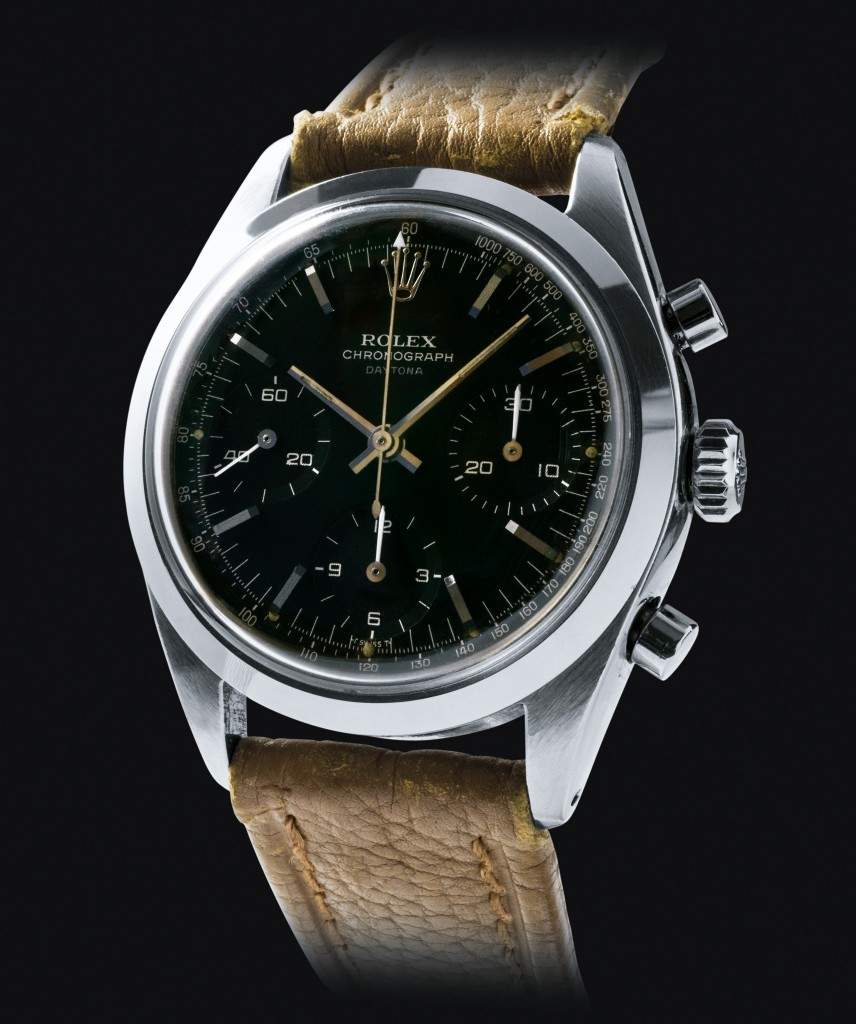
(Credit: We are thankful to John Goldberger (for the pictures) but also to Andrew Shear who pointed out this rare model to us).
The next two models and pictures explains even better just how close the Pre-Daytona 6238 was to the 6239 first Daytona. It is a watch that was sold by Christies in 2014: a 6238 ‘Solo’ Pre-Daytona. Yes this watch below is a Pre- Daytona 6238!
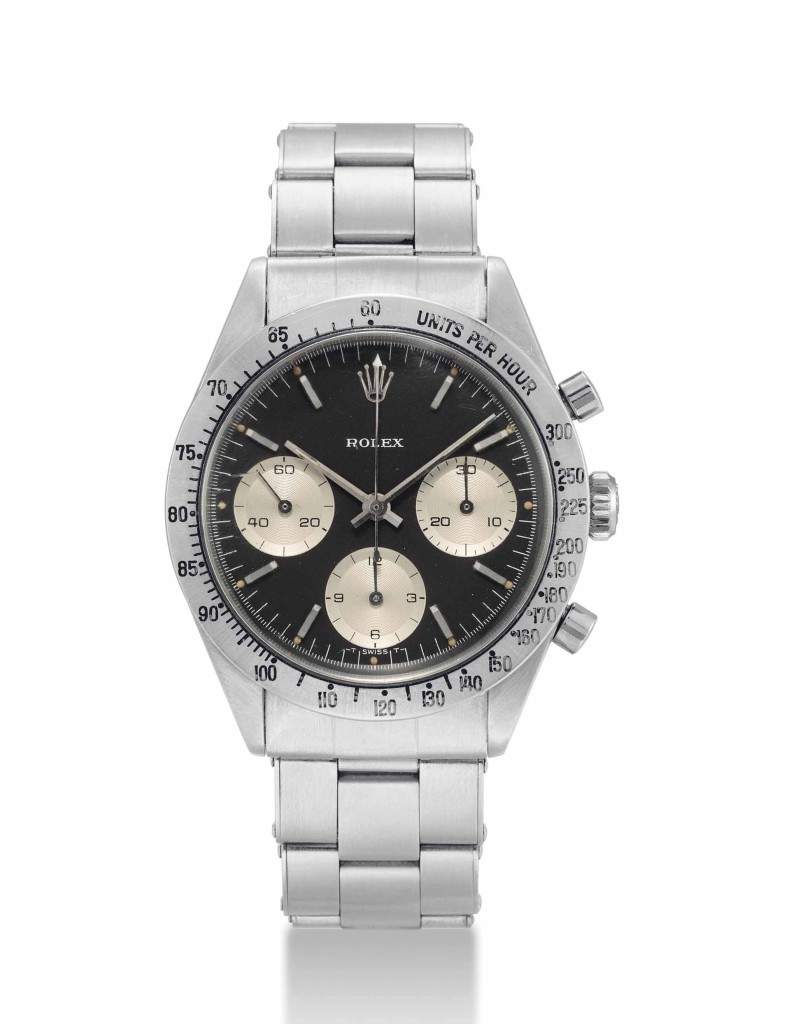
(Credit: Christies Images Ltd 2014).
Notice the tachymeter scale now found on the steel bezel (see picture above) – with a scale calibrated to 300. The term ‘Solo’ was given to this watch given the Rolex only signature. This type of signature is also found on a later model which replaced the 6239 – the 6240 which had a plastic/bakelite bezel insert rather than steel. The astute collector will also notice the hour and minute hands below of the 6238 which are now obviously ‘extended’ and are the extremely rare ‘thin’ versions found on only the earliest Daytona, also on the 6239 Double Swiss.
The 6238 Pre-daytona Solo model came out in 1963 with serial Nr 964 xxx almost simultaneously to the launch of the 6239 first Daytona, the 6239 Double Swiss which would carry a serial number 923 xxx (this just shows you how close the Pre-Daytona and the Daytona are). Rolex would continue to Pre-Daytona Rolex long after the Daytona was introduced and first stopped the Pre-Daytona in 1968 so fours after the Daytona.
We have found another rare 6238 model which shows the transition between Pre-Daytona and Daytona. This watch also a Rolex solo but still carries the smooth bezel and case found in the Pre-Daytona. However the dial is now that of a Daytona with the different sub – dials and longer hands.
Call it the ‘solo 6238’ Pre-Daytona if you will. I think it is absolutely stunning!
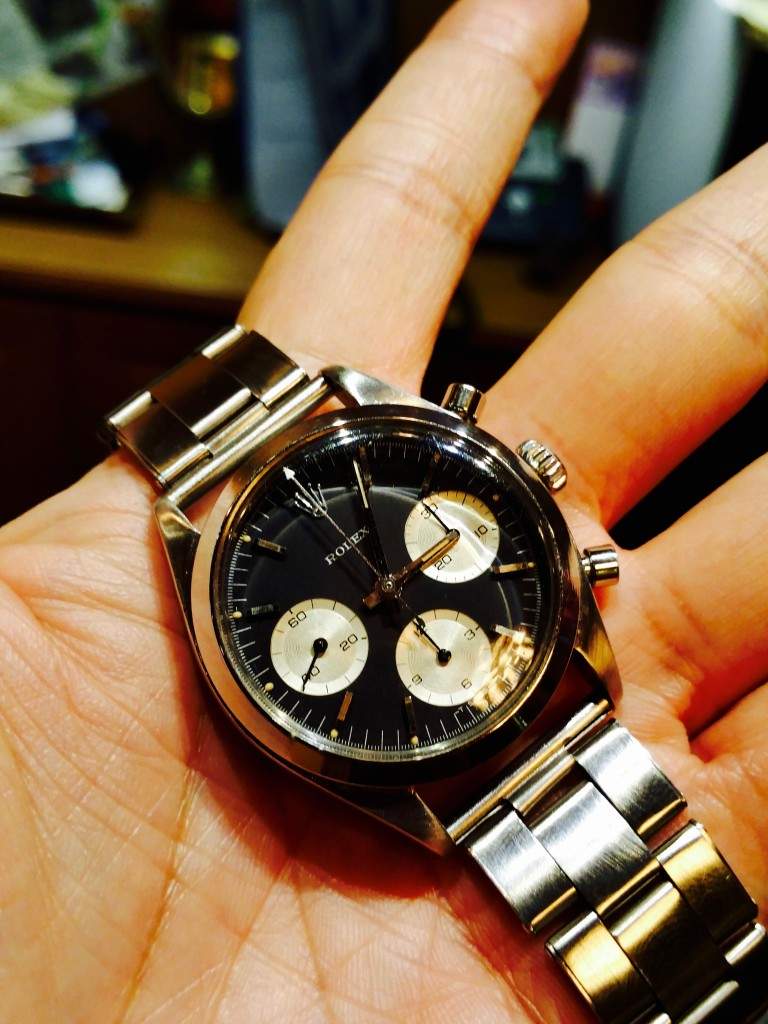
(credit: Iceman).
We are pointing this out because collectors often assume that the Pre-Daytona stopped production right after the 6239 Daytona was introduced which is not correct. Both co-existed for more than four years and therefore it is not surprising that many Pre-Daytona have hands today of the Daytona.
Just for your viewing pleasure another Rolex Solo dial 6238 Pre-daytona. There is something very pure about this watch.

(Credit: Il Signori del Tempo)
On a last note the 6238 even has some film credit to its name. It was featured in one Bond movie OHMSS (On Her Majesty’s Secret Service) made in 1969.
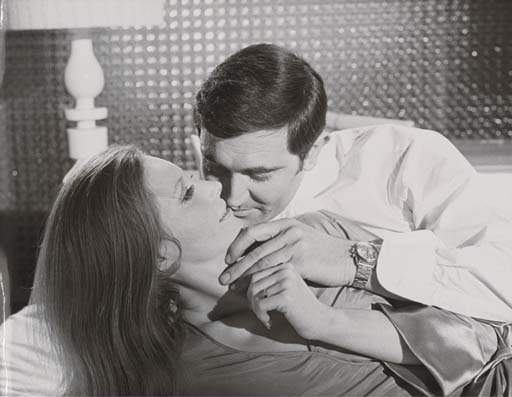
The watch was once auctioned at Christies in 2003 for £21k and is not back for sale at the auction house Artcurial. Below is the original receipt and invoice to EON productions for CHF 790 in 1968!
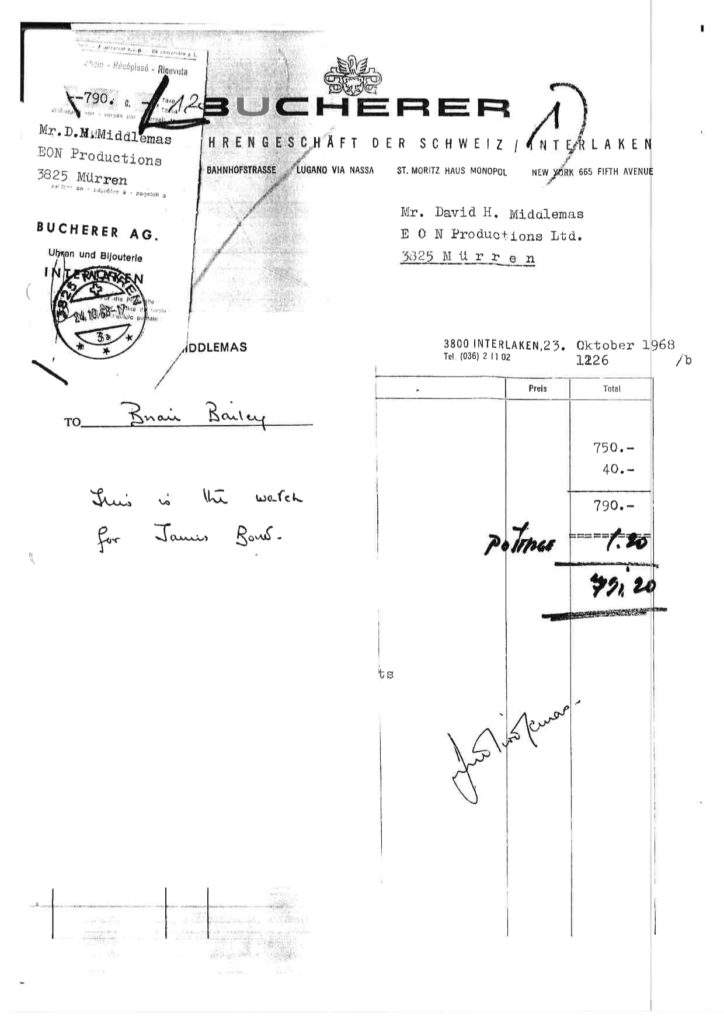
(Credit: Artcurial).
(For full disclosure I or my trust own a black dial 14k Gold 6238). I would like to thank the following people for their help in proving information on the 6238: A Shear, Manuel D, and Teddy D. Also thank you Wulf, Goldberger and especially Boutros P for the pictures. Special thanks also to J Gerber who gave me great insight into how to think about Rolex and aesthetics in general.
